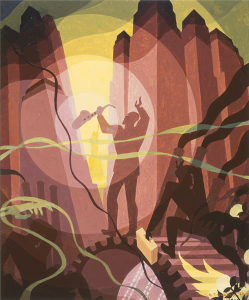Our most recent IQ offers student perspectives on one of America’s most important interdisciplinary arts movements: The Harlem Renaissance! Points of departure include the Great Migration, First World War, Summer of 1919, Jazz Age, Cotton Club, Crisis Magazine, James Weldon Johnson, WEB Dubois, Claude McKay, Countee Cullen, Langston Hughes, Angela Grimke, Jean Toomer, Helene Johnson, Zora Neale Hurston, Aaron Douglas, Florence Mills, Duke Ellington, Louis Armstrong, Carl Van Vechten, and the Civil Rights Movement. Langston Hughes, the leader of the Harlem Renaissance, was educated at Columbia University and published his first book of poetry, The Weary Blues, in 1926. In his groundbreaking essay, The Negro Artist and the Racial Mountain (1926), Langston Hughes expresses the energy and vision of the Harlem Renaissance movement as African-Americans “catch a glimmer of their own beauty” (Hughes) in “the blare of Negro jazz bands and the bellowing voice of Bessie Smith singing the Blues [and] Paul Robeson singing Water Boy, and Rudolph Fisher writing about the streets of Harlem, and Jean Toomer holding the heart of Georgia in his hands, and Aaron Douglas’s drawing[s]…” (9).
Song of the Towers by Aaron Douglas

IQ has the beat covered from Eatonville, Florida to New York, New York. Tamedra Fuller and Kristen Newman invite us to consider the Harlem Renaissance as a dazzling, multifaceted, and central movement in American cultural history. Brian Fermin focuses on the poetic power of both Langston Hughes and Claude McKay. Cierra Forrest follows the queen of the Harlem Renaissance, Zora Neale Hurston, from Eatonville to the Everglades in her analysis of How It Feels to Be Colored Me (1928) and Their Eyes Were Watching God (1937). Shada Parker and Sandra Huber remind us of the more somber economic realities of the time, place, and movement—also documented in This Harlem Life: Everyday Life and Black Families in the 1920s and 1930s (Oxford University Press). Our IQ team explores the ways in which characters struggle to make a difference despite injustice and oppression—from the rural South to the Big Apple. IQ celebrates the interdisciplinary arts of the Harlem Renaissance: Their beauty and power enrich and inspire us. Thank you, Langston Hughes et al!
Works Cited
Hughes, Langston. The Negro Artist and the Racial Mountain (1926). Rpt. Collected Works of Langston Hughes, ed. Christopher De Santis. Columbia: U Missouri Press, 2001.
Mays, Kelly et al. The Norton Introduction to Literature. W. W. Norton & Company, 2016.
Robertson, Stephen. This Harlem Life: Black Families and Everyday Life in the 1920s and 1930s. Journal of Social History. Vol. 44, No. 1. Oxford University Press, 2010.
Cover Image: Harlem Renaissance Literature: Creative Commons
Image: Song of the Towers by Aaron Douglas via Wikimedia Commons

